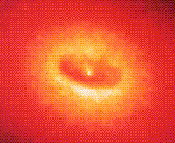
Black Holes Capture
More Than Your Imagination

Black Holes Capture
More Than Your Imagination
|
But, they aren't imaginary anymore. How do we know that? If there's such a thing as a black hole — a place where the gravity is so strong that light can't even escape from it — how would you know where to look for it? The search for black holes has a lot in common with reading cheap detective novels — you run into a lot of circumstantial evidence, smoking guns, and mysterious strangers speaking in unusual languages. But, reading cheap detective novels can be fun, and so can looking for black holes. So, let's get started. To figure out if there's a black hole in the center of NGC 4261, you have ask yourself (or a nearby astronomer) the big question: What exactly is a black hole,anyway? The answer, as you might expect, involves strangers speaking in tongues. So, let's learn the language... First, you'll find out that there are three flavors of black holes: mini stellar supermassive We're not going to talk about mini-black holes right now, because we'd be delving into such stuff as the age of the universe, Stephen Hawking's theories, and a variety of other fascinating, but complex things. (Well, we could, but there's only so much room on this Web site... ) However, we will talk about stellar and supermassive black holes. A stellar black hole is easy to remember: it is a place where a star has collapsed to a very small, very dense region with a strong gravitational pull — a singularity. A supermassive black hole contains the mass of thousands or millions of stars of high mass and gravity. You're most likely to find these beasts at the hearts of galaxies. Quasars (quasi-stellar radio objects, or QSOs) are also thought to have supermassive black holes containing the masses of billions of stars. So How Does Gravity Work With These Things? The more massive the star (or collection of stars) that formed the black hole, the stronger its gravity will be. Which means that anything trying to get away from the immediate area around a black hole will have to travel faster and faster to get away. Stuff very, very close to a black hole doesn't stand a chance — it gets sucked right in: gas, dust, light, planets, stars, starships, etc. The speed that an object has to travel to get away from a black hole (or to leave any gravitational "well") is called its "escape velocity". The outer boundary of a black hole is called its "event horizon". This is the place where the gravitational pull of the hole exactly matches the speed of a light beam trying to escape. Implications For Starships To look at it another way, if you're out in your favorite Galaxy-class starship, and you get a hankering to visit a black hole, AND IF you head STRAIGHT for the hole, eventually you'll cross its event horizon. At that point, it's too late to reverse thrusters and back out. The gravity of the black hole will overcome your escape velocity and you'll become a new Black Hole Denizen, going where no Galaxy-class starship has gone before (except in the movies, where all bets are off and all laws of physics apply only when the producers find it convenient). It could be interesting, but of course, nobody outside will know about you. You'll have to form your own federation with all the other starships stuck in there with you. (This, of course, assumes you've all found a way to escape being instantly crushed into a singularity.) Any information about you will be carried on light waves or radio waves — and guess what? The escape velocity of light can't overcome the gravitational force of the black hole. Your signal beacons, subspace hailing frequencies — anything you use that depends on the electromagnetic spectrum — are pulled back into the black hole. Information is lost forever. There are weirder aspects to the problems of gravitation in and around black holes, but in essence, this is how gravity works for any size black hole. All of this is by way of saying that unless you get very, very close to a black hole, you aren't likely to get sucked into it. If, for some reason known only to astrophysicists, the Sun should turn into a black hole tomorrow, you'd have to be within 3 kilometers of the black hole before you'd get sucked into it. (To my fellow Trekkies: yes, I know that Warp speeds are multiples of light speed, and theoretically any Galaxy-class starship worth its Jeffries Tubes should be able to get out of all but the largest supermassive black holes. However, let's not clutter up the discussion with that stuff now... remember that those higher warp speeds are still against Federation law!) How Do We Know Where to Look For a Black Hole? 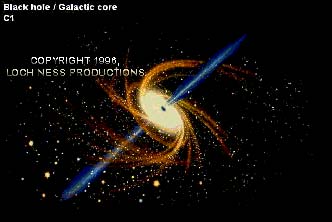
This artist's conception of a black hole (copyright Loch Ness Productions) gives an idea of what's happening around a "galactic" black hole. Chances are, if you're out cruising the universe in your starship, you'll have detectors to help spot such things as x-rays, ultraviolet light, etc. One way to use these detectors is to search for jets of high-speed material streaming away from stars, out of the centers of galaxies, and as pointers to the powerful central "engines" of quasars. "But wait", you cry. "I thought you just said that black holes suck stuff into them! Wouldn't we be looking for places where streams of material are moving toward an unseen object?" Yes, we would. Actually, we could look for both. As stuff gets sucked in toward the black hole, it moves faster and faster. Eventually, it's moving at velocities very close to the speed of light (remember, the gravitational pull of the black hole is strong enough to keep light from escaping, which means that it's sucking hard enough to make things move at the speed of light as they make their final approach). Close to the black hole, LOTS of stuff is moving in at near-light-speed velocities. When you have a lot of material moving fast in a small region, you get friction. Friction heats things up to super-high temperatures, and some superhot matter shoots back out away from the black hole, giving off radiation in the form of x-rays. So, look for a jet of material leaving the scene at high speeds, and try to find lots of x-rays being given off. These are two important clues that what you're seeing is a black hole. So, What About NGC 4261 Here? 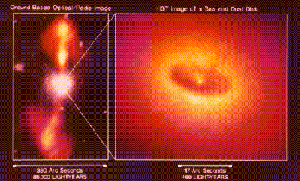
Well, it's a giant elliptical galaxy (meaning it's shaped like an oblong instead of a spiral) in the Virgo Cluster of galaxies. It's about 45 million light years away. If you could eyeball this galaxy, it would look like a fuzzy disk-shaped collection of stars. Look at it with a radio telescope, as astronomers did when producing the image on the left, and you see a big pair of jets emanating from the central core. This is, as they say in cheap detective novels, the "smoking gun". In other words, it's good circumstantial evidence. Which brings us back to the cheap detective novels. Somewhere along the line, the hero finds a victim lying there on the floor with a bullet hole in him (or her), and a smoking gun lying next to him (or her). No one else is in sight. With a great display of deductive reasoning, the detective twirls his mustache and says, "I have deduced that this person was shot by this gun." If the detective was Sherlock Holmes, we'd also be informed that the killer was a drunken sailor who walked with a limp, drank lapsong souchong tea, and had recently retired from Her Majesty's Service. (And it also wouldn't be a cheap detective novel, but I digress... ) In the case of NGC 4261, our Holmesian detective is an astronomer,who sees the jets brazenly coming out of the center of the galaxy. So, Intrepid Astronomer figures, these jets must be the result of matter being accelerated toward a black hole. Once it crosses the event horizon it's gone, but nearby superheated gas escapes the clutches of the black hole and squirts back out at high speeds. Look at this thing in x-ray wavelengths and it's like a flashing neon sign above a roadside restaurant: "EAT HERE!" (Only, in this case, the black hole would be the eater, and if you were unlucky enough to get too close, you'd be the "eat-ee.") What got eaten here? One likely explanation is that a smaller galaxy fell into the core of NGC 4261. The black hole, being ever-hungry, will (of course) gobble up the gas and dust from the intruder. That's not the only possibility, and it's kind of hard to simulate something as complex as the core of one galaxy chowing down on another galaxy. In fact, for this thing to work, the intruder galaxy had to be headed straight for the black hole in a sort of cosmic suicide leap. It's not impossible, but scientists need to do some more modeling to see if this is really what happened. |

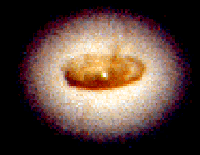
|
|
What's even stranger is that this particular black hole seems to be off-center instead of right smack in the middle of things where it belongs. Notice in the Hubble Space Telescope image on the left (taken in 1992) a small V-shaped region appears. It's not the black hole itself (remember we don't see that), but a jet of material flowing away from the black hole. In the image on the right, taken by HST in late 1995, that region appears to be offset from the center. In fact, this 1.2-billion solar mass black hole — which is concentrated into an area only about the size of our own solar system — lies an incredible 20 LIGHT-YEARS away from the center of the rotating disk of gas and dust that defines the heart of NGC 4261! Now we've already talked about how massive black holes are — in fact, they ought to be the classic examples of immovable objects. The Space Telescope Science Institute described this black hole as the "astronomical equivalent of a 1,000-pound gorilla" doing anything it wants. So, what's it doing? One scientist suggested that perhaps the black hole is propelling itself around, sort of like a cosmic pop bottle rocket. Hot gas jets out from the black hole, pushing it around just like jet exhaust in a rocket engine. This is really exciting news for our Intrepid Astronomers, who will continue to study this thing for some time to come. Let's go back to our starship for a moment. If something active shows up in the sensor logs, and it looks like a black hole and quacks like a black hole, it's probably a black hole. The next thing you do is go about proving there's really one in the crosshairs. What If It's NOT a Black Hole? You don't even want to think about that. To paraphrase one scientist who used the Hubble Space Telescope to look at something energetic at the heart of an active galaxy, if it didn't harbor a black hole, there was probably something even weirder going on there, and he wasn't sure he wanted to try and explain something stranger than a black hole. To prove it is a black hole, it would be nice if you could see the event horizon, but of course, no light can escape from it. And, as we've noted above, nudging up against the boundary of the black hole isn't a good idea. So, you're forced to fall back on Plan B and make do with circumstantial evidence. In this case, you take a look at those images of NGC 4261 (back up a screen)which are supplying some pretty good circumstantial evidence. What shows up is (literally) the next best thing to an event horizon: a disk of cold gas and dust, spiraling into something at (or near) the center of the galaxy. As that cold matter spirals in, it travels faster, gets heated — and you know the rest of the story. There's that famous little V-shaped region we've discussed, squirting hot gas out. The Cosmic Motion Detector There is another way to study black holes, and that's to measure the motion of the disk of gas and dust around the mouth of the hole. Astronomers looked at another black hole candidate with a spectrograph, which helped determine the speed of a gas disk swirling around the maw of a black hole, feeding its voracious appetite. The Hubble Space Telescope's Faint Object Spectrograph measured the velocity of material in the disk surrounding another suspect. This one is at the heart of galaxy M87, which has a jet easily seen in optical wavelengths (i.e. in visible light). 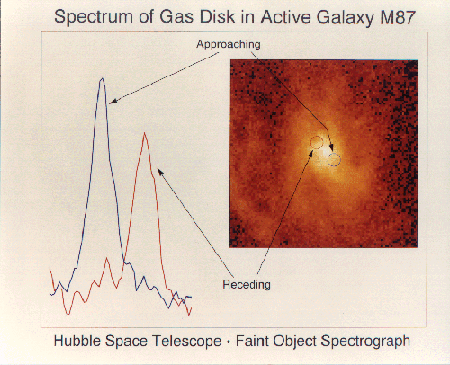
The image above illustrates the action. On the right is the WF/PC-2 image of the core of M87. There is a barely-recognizable disk in the center of the galaxy. Notice two circles — these indicate material which is either moving toward us (the blue circle) or moving away from us (the red circle). It's like looking at a spinning merry-go-round. You notice that part of it is moving toward you while another part is moving away from you. If you could use the spectrograph to study the movement of the merry-go-round as it spins, you'd be able to figure out how fast the merry-go-round is moving. In much the same way, astronomers have measured the central spinning "merry-go-round" in M87 — another strong piece of circumstantial evidence for the existence of a 2.4-billion (yes, BILLION) solar mass black hole. And so, to summarize... Well, the conclusion you can draw from this little digression on black holes is this: Yes, Virginia, there is a black hole at the center of NGC 4261. And in the middle of M87. And probably lots of other places as well. photo credits: NGC 4261 Artist's conception of a black hole M87 spectrum and photo Now that you've got a nodding acquaintance with black holes, you can close this box to head back to the gallery. |